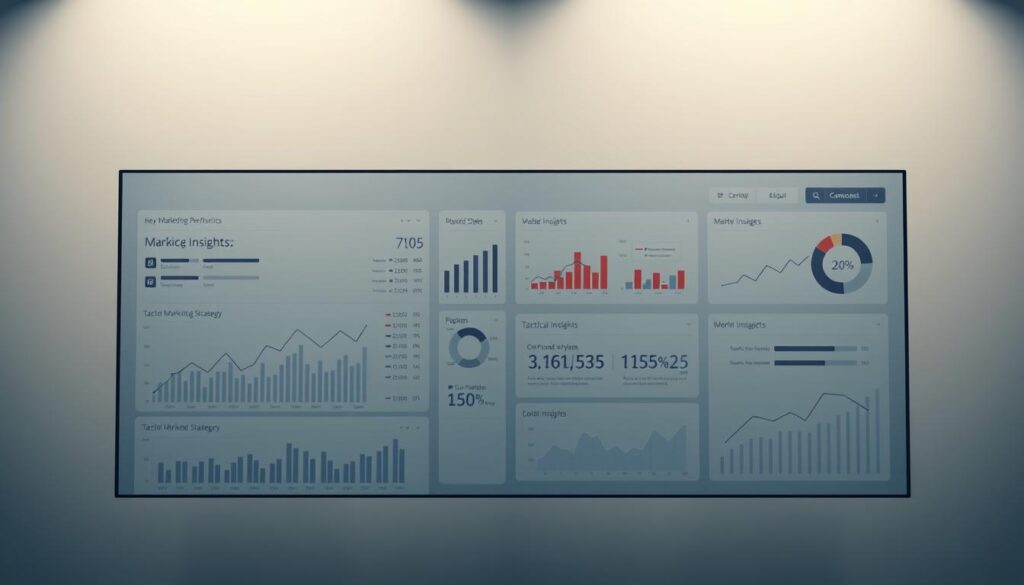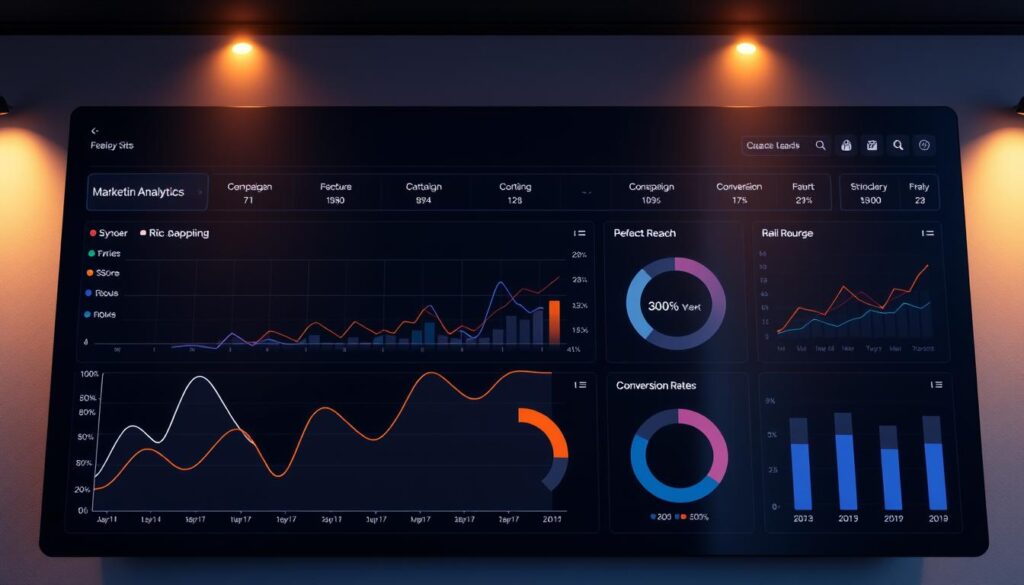Did you know 54% of marketers can’t accurately measure ROI across their entire sales funnel? A recent Nielsen study reveals this alarming gap in tracking campaign effectiveness. Without clear insights, businesses risk wasting budgets on strategies that don’t convert.
Here’s the good news: Companies leveraging actionable analytics achieve 2.3x higher returns on ad spend compared to competitors. The difference lies in turning raw numbers into revenue-generating decisions. But how do you bridge the gap between scattered metrics and profitable outcomes?
At Macro Webber, we specialize in Performance Marketing That Drives Revenue®. Our approach transforms fragmented information into targeted strategies that align with your business goals. Instead of guessing what works, you’ll identify high-impact opportunities hidden in your campaigns.
Key Takeaways
- Over half of marketers lack full-funnel ROI visibility
- Strategic analytics adoption triples advertising returns
- Actionable insights eliminate guesswork in budget allocation
- Proprietary methods convert metrics into measurable growth
- Real-time adjustments maximize campaign performance
Understanding the Importance of Data in Marketing
Data emerges as the quintessential compass, steering the trajectory of every efficacious marketing strategy within the digital epoch. By leveraging concrete insights over mere conjecture, marketers can achieve unparalleled precision in targeting, tangible growth, and the fortification of customer bonds. This discourse aims to elucidate the effective utilization of this potent resource.

The Role of Data in Decision Making
Organizations that adopt a data-driven approach are 23x more likely to acquire customers than those reliant on intuition. The notion of discerning which advertisements resonate with your audience or forecasting seasonal demand surges before competitors is not alchemy—it is the outcome of scrutinizing behavioral patterns, transaction histories, and engagement metrics.
For instance, Macro Webber’s clientele witnessed a 40% enhancement in campaign ROI subsequent to embracing their data prioritization framework. This paradigm shift ensures that every financial allocation is backed by empirical evidence, minimizing the propensity for costly missteps.
Common Data Sources for Marketers
Marketers predominantly leverage two data categories:
- First-party data: Directly garnered from the audience (website analytics, CRM systems, email interactions)
- Third-party data: Acquired from external entities (demographic trends, psychographic profiles, geographic hotspots)
With the impending obsolescence of third-party cookies, Macro Webber’s hybrid methodology integrates zero-party data (voluntary customer surveys) with AI-driven predictive modeling. This juxtaposition elucidates the comparative utility of these data sources:
| Data Type | Source Examples | Best For |
|---|---|---|
| First-Party | Purchase histories, app usage | Personalization |
| Third-Party | Industry reports, social listening | Market expansion |
| Zero-Party | Customer preference surveys | Product development |
Key Metrics to Measure
While rudimentary KPIs such as click-through rates hold significance, advanced metrics unveil profound insights. Macro Webber’s proprietary Customer Lifetime Value (CLTV) formula considers:
- Average purchase frequency
- Cross-selling capacity
- Referral propensity
“Entities employing CLTV-driven strategies exhibit 20% superior profitability compared to those solely focusing on acquisition expenditures.”
It is imperative to monitor these four critical metrics:
| Metric | Calculation | Ideal Benchmark |
|---|---|---|
| Customer Acquisition Cost (CAC) | Total sales & marketing expenditures ÷ New customers | 3:1 CLTV:CAC ratio |
| Conversion Rate | Conversions ÷ Total visitors | 2-5% (varies by industry) |
Strategies for Data-Driven Marketing
The transformation of raw data into actionable strategies necessitates a systematic methodology. This involves three fundamental phases: data collection, analysis, and implementation. These steps are instrumental in converting numerical data into tangible business growth. Let us dissect the intricacies of each phase with meticulous precision.

Collecting Reliable Data
The potency of your marketing strategy is directly correlated with the quality of the data it utilizes. Initiate by identifying credible sources such as CRM systems, customer surveys, and analytics tools from your website. It is imperative to eschew third-party data, instead focusing on first-party insights derived directly from your audience.
Best practices include:
- Establishing precise data collection objectives that align with campaign goals
- Employing GDPR-compliant tracking methods to uphold user trust
- Conducting regular audits of data sources to ensure accuracy and relevance
Analyzing Data Effectively
Post-data collection, leverage predictive modeling to unveil concealed patterns. Delve deeper than superficial metrics; scrutinize customer behavior clusters and identify bottlenecks in the purchase journey. Advanced segmentation is critical in pinpointing high-value audiences for targeted marketing efforts.
| Analysis Method | Purpose | Key Outputs |
|---|---|---|
| Predictive Modeling | Forecast campaign performance | ROI projections, risk assessments |
| Customer Segmentation | Identify target groups | Personalization opportunities |
| Sentiment Analysis | Measure brand perception | Engagement optimization insights |
Implementing Insights into Campaigns
Utilize your insights through controlled A/B testing. Initiate with small audience samples, gradually scaling successful variations. Case studies affirm that this methodology can elevate conversion rates by 37% compared to untested campaigns.
“Real-time data adjustments during campaigns increased our click-through rates by 22% within one quarter.”
Perpetually monitor performance across various channels, including email and social media. Utilize dashboards to track metrics against benchmarks, facilitating weekly adjustments based on current data streams.
Tools and Technologies for Data Analysis
The efficacy of your marketing strategy hinges on the sophistication of its underlying tools. With 73% of enterprises placing a premium on data-driven marketing decisions, the selection of analytics platforms is critical. This choice can either elevate or undermine your marketing endeavors. We will dissect the process of aligning advanced technologies with your specific objectives.

Popular Marketing Analytics Tools
Platforms such as Google Analytics and Tableau lead the market due to their robust capabilities. These tools provide:
- Real-time campaign performance tracking
- Customizable data visualization dashboards
- Cross-channel attribution modeling
Starbucks’ AI-driven loyalty program exemplifies the transformative power of data analysis. It leverages over 400 data points per customer to craft personalized offers. For organizations seeking bespoke analytics solutions, platforms like Macro Webber’s custom analytics dashboard merge disparate data sources into cohesive insights.
How to Choose the Right Tool for Your Business
Utilize this decision matrix to assess various options:
| Factor | Google Analytics | Tableau | Enterprise Solutions |
|---|---|---|---|
| Implementation Speed | 1-2 days | 3-5 days | Custom timeline |
| Actionable Insights | Basic | Advanced | Tailored |
| Support Level | Community forums | Premium plans | Dedicated team |
Before making a commitment, pose these essential inquiries:
- Does it integrate with your existing tech stack?
- Can non-technical team members use it effectively?
- Does it scale with your growth projections?
“The best tool isn’t the most expensive one—it’s the one your team will actually use daily.”
Seeking guidance in your tool selection? Contact +91 (353) 405-7665 or email hello@macrowebber.com for a tailored assessment. Our specialists will scrutinize your data streams and campaign goals to suggest solutions that promise tangible ROI.
Leveraging Data for Customer Engagement
Data-driven marketing revolutionizes the manner in which enterprises engage with their audience. Macro Webber’s client campaigns exemplify the efficacy of closed-loop analytics in transforming mere statistics into actionable methodologies. Initiating this transformation involves the meticulous alignment of data insights with customer behavior patterns, fostering interactions of profound significance.
Personalizing Marketing Messages
Netflix’s recommendation engine, fueled by an in-depth analysis of viewing history, enhances engagement by a staggering 35%. Employ analogous strategies by segmenting your audience based on purchase history or website activity. The implementation of personalized emails with dynamic content has been observed to elevate open rates by 26%, as evidenced by Macro Webber’s campaigns for e-commerce entities.
Measuring Customer Satisfaction
Monitoring Net Promoter Score (NPS) serves as a metric for gauging customer loyalty. A Macro Webber client in the hospitality sector witnessed an 18-point improvement in NPS following an analysis of feedback loops. Employ surveys and sentiment analysis tools to pinpoint areas of discontent. Real-time adjustments, informed by this data, effectively mitigate churn and enhance repeat business.
Continual Improvement through Data Feedback
Refine your strategies through the analysis of A/B test results and campaign metrics. A retail brand, leveraging Macro Webber’s Performance Marketing That Drives Revenue® methodology, optimized its ad spend by 40% within six months. Regularly update customer profiles and automate data flows to maintain relevance in rapidly evolving markets.
Opt for tools that consolidate disparate data sources, such as Google Analytics or HubSpot, to facilitate streamlined decision-making. Each interaction presents an opportunity for learning and adaptation. Macro Webber’s framework demonstrates that iterative, data-driven refinements cultivate enduring customer relationships and sustainable growth.



